SSX Tricky
Reviewed on Nintendo Gamecube
Developed by: EA Canada
Published by: EA Sports BIG
December, 2001. My 10th Christmas brought into my life a quirky, adorable little box called a Nintendo Gamecube and I could not have been more thrilled. The Nintendo 64 had (with no hyperbole) changed my life and the idea of getting my hands on the next generation Nintendo was something I absolutely needed. While most of my friends were pivoting to Sony’s Playstation 2 (the most accessible means to a DVD Player at the time) or Microsoft’s new behemoth called the Xbox, I was undoubtedly a Nintendo kid and that was what I wanted above all else. From what I remember, I received three games at Christmas - Luigi’s Mansion Star Wars - Rogue Squadron II: Rogue Leader, and Super Smash Brothers Melee. I love these games to this day and put in hundreds of hours between them; however, a fourth game came to my attention quickly after that during my holiday break. Visiting a friend’s house who had also received a Gamecube, we immediately jumped into Smash Brothers and after getting worked over a few rounds, he decided we should try something different. Little did I know… things were about to get… TRICKY.
My knowledge of “extreme” sports games at this point had almost entirely been rooted in some sort of believable reality. Sure, I understood that the Tony Hawk games weren’t exactly the most 1 to 1 example of skateboarding, but it was certainly more grounded in reality. I knew that the tricks that the skaters would do could be performed in a real life setting. With regard to snowboarding, 1080 Snowboarding was as much a simulation that could be achieved in the mid to late 90’s. So when my friend fired up SSX Tricky, and the introductory video kicked in and I saw a dude rocking an orange afro hitting the worm on his snowboard 100 feet above the ground, I almost couldn’t believe it. I had never been exposed to a game quite like this before; it was as if I was hearing a language I knew but in a dialect I didn’t quite understand. Within a few minutes of playing, I knew exactly what my gifted Christmas money was going to be spent on.
A Brief History
The brainchild of former professional skier Steve Rechtschaffner, he originally developed the idea of a competitive Olympic that translated the format and landscape concepts of motocross to snowboarding. This was eventually adopted for the 2006 Winter Olympics in Turin and has subsequently featured in every Winter olympics since. After bouncing between a few different industries, including marketing and television production, Rechtschaffner took a job with Electronic Arts as a producer to assist in their development of cameras to utilize for their first foray into 3D game creation.
Rechtschaffner eventually took on the producer role for the EA Triple Play baseball series of games, which garnered enough success for him to eventually be provided the opportunity to produce a game of his choosing. He presented the concept of SSX to EA, who greenlit the project to initially be developed for the SEGA Dreamcast and launched under a more experimental publishing house of Electronic Arts called “EA Sports BIG.” However, disagreements between EA and SEGA led to EA abandoning the Dreamcast and production was moved over to the Playstation 2. SSX launched on October 26, 2000 and was met with critical acclaim, earning a 93 Metacritic score and gave Rechtschaffener the license to move forward with SSX.
Initially being developed to simply feature “cut” features from SSX, its success immediately encouraged EA to allow Rechtschaffner to recruit more personnel from within EA to his project and aim for a full sequel. Rechtschaffner and co-producer Larry LaPierre recruited Adam Mackay-Smith, who was working on the Need for Speed franchise at the time to assist and push to fully realize their vision of what SSX could be. Originally called SSX: DVD, the later addition of the license to use Run-DMC’s “It’s Tricky” led to the birth of SSX: Tricky, with all the goods that DVD was going to initially include and then some.
Mechanics
It’s important to start with what is arguably the most important part of a video game and that’s how it FEELS. Feel is what really makes the player come back for more, and SSX Tricky involves breakneck speeds and gravity-defying leaps that demand the player feeling that they are (mostly) in control of what they are doing. To be quite honest, I never owned a PS2 and as such I missed the original SSX, so I can’t compare how Tricky improved upon the original. What I CAN say is that the team at EA Sports BIG stuck the landing BIG time, with every monster air and technical maneuver the player hits for big points or seconds off their run time. As the player gains stat points for their rider’s set of skills, they become faster (whether on the downhill or hitting tricks) and sharper in their movements hitting berms and corners. I can’t tell you how many times I’ve yelled out a few expletives after hitting a massive air, doing insane moves that only result in “???” for huge points. Given the time this game came out, it could be said that the developers were ambitious as hell, pushing the word “extreme” in extreme sports to new heights (quite literally). However, with that ambition come some frustrating incidents of clipping an invisible object, passing through a rail the player is trying to grind, etc… On one occasion, I clipped through the entirety of the stage, falling into infinite space before hilariously being reset way ahead of the pack and sheepishly crossing the finish line for a gold medal (which then took one of the sound tracks completely out of the game; not wanting to push it, I made sure the game saved and Given the level of ambition that the team was chasing, it's not surprising there would be some bugs here and there. Annoying? Yes. Enough to detract from the overall experience in any significant way? Not even close.
Grade: A
Sights and Sounds
The jump from Generation 3 to 4 in the modern era of home consoles was a truly significant one, especially from an audiovisual perspective. Disc-based storage provided a cheap, plentiful source for developers to create with and with computing processors starting to become a bit faster, digital game spaces started to become more ambitious in their sights and sounds. Jumping into Garibaldi for the first time and seeing the beautiful vistas on the horizon as the player makes their first attempt at launching into the heavens is striking. Does it have the photorealism that games of this generation have? Of course not. But you can see that in most cases, the work being done during this generation was laying the foundations for developers to get there. And to be perfectly clear, this game still looks awesome! The team at EA Sports Big really did their best to be meticulous in making this world feel lived in, yet larger than life. The coloration and lighting of each stage adds to the “mood” of each stage, immersing the player in every moment to moment maneuver. Add in some fireworks setpieces and grandstands and what you have is a form of extreme sports theater. It’s meant to be a spectacle for those in attendance and those participating in it, pushing the limits of human performance before an enthusiastic audience.
What would a spectacle like this be without the audio experience to go with it? Flat. And flat just isn’t going to cut it in an extreme exposition that relies on frequent altitude adjustments like this! Even the more casual player (who isn’t a music and sound geek like me) can identify just how important the music and sounds are to enhancing the overall experience of this game. Before I start waxing lyrical about the music and voice acting, it’s important to note that the sound effects team were doing some cutting edge stuff here. Prior to this, most video game sound effects and instruments were MIDI-based (musical instrument digital instrument) and with the greater storage and computing power came the ability to begin to implement real-life noises and instrument tracks. And while I could get SUPER nerdy and begin to delve deep into the audio production, I would rather pass it off to Jack Yarwood, who wrote and published a truly excellent deep dive on fanbyte.com into the incredible process by which the signature sounds came to be. (The link to this article* can be found here or at the bottom in the footnotes of this piece)
Instead, what I will say is that landing a massive signature move to hear “TRICKAAYYYYYYY” explode through the speakers with a huge boxing ring bell sound coming through is a shock to the senses in the best way, leaving the player begging that around the next corner is a massive jump to reach that high again. Stomping the landing leads to a satisfying “crunch” of perfection under the boarders weight and carving through fresh powder cuts through airwaves with a satisfying “woosh” that creates a sense of speed and texture unique to the environment. The heavy “thud” and “ping” that comes with a player misjudging a flip or cutting a corner too close to an object sounds damn painful, and one would have to assume your rider just broke something, though they’ll play it off with a hilarious quip or moment of self-loathing. Probably best to rub some snow in it and get lost in the jams to tune out the pain.
A carefully curated set of tracks from seriously big-time music producers and artists are collected here; an absolute reflection of the time in which they were produced, melded seamlessly with a game that was a reflection of its time. Art of any medium that does this well are those that become “timeless,” and while it may be a bit exaggerated to some, I speak in no such hyperbole when I say that this is one of those instances. Aside from introducing a whole new generation of listeners to one of the most important musical groups of the modern era (Run-DMC) with the titular song and its subsequent remixing in the game, the soundscapes heavily feature some of the best to ever do it in the realms of dnb (drum and bass), jungle, and hip-hop. Mix Master Mike of the Beastie Boys (producer Adam Mackay-Smith wanted the Beastie Boys in their entirety but they did not license their music out commercially), BT, and Aphrodite are all featured here, not to mention character specific music pieces that feature Black Label Society and Bif Naked. Did I forget to mention the one and only Rahzel is here to MC the entire journey (and chastise you for repeating a trick too often)? I have little doubt that the soundtrack here led to some extremely formative music experiences for younger players like myself, which EA had a knack for doing in this era of game development.
On top of this, EA pulled out all the stops and brought in an absolutely electric voice cast that set a high bar for many for creating vivid, unique characters in this genre of gaming. This is not a narrative heavy, 100 hour role playing game. These characters have defined characteristics and backgrounds that inform their identity and the voice cast are hugely responsible for breathing life into these characters that make them unforgettable. Lucy Liu, Oliver Platt, David Arquette, Billy Zane, and Macy Gray are here (wild!), but the entire cast is brilliant and they each provide a collection of one-liners that I unapologetically still quote out of context to this day. And who could forget “Mean” Gene Okerlund as the narrator of both the stage introductions and the post-event! It’s insane by modern metrics all of this came together the way it did and we (the players) are all the luckier that it did.
Grade: A+
Design
After constructing the foundations for the courses in SSX, the team at EA Canada now had the opportunity to push themselves and realize their true vision for the world they had created. The six original courses from SSX return, while two more tracks are added to the “World Circuit” section, and two more are available in the “Free Ride” section. Loading into the character and stage selection sections immediately informs the player that they are about to jump feet first into something BIG. Excellent sound design, character animations, and voice acting immerse the player in an established world that is ready to be conquered by the rider of choice. This in and of itself is enough, but the EA Canada team go even further by crafting a narrative through an established backstory and fictional interview that fleshes out these characters to an even greater degree. I can imagine that many have missed this, but as someone who loves a personal narrative, I really appreciate the time the writers took to tell the stories of this incredible cast.
Introducing a brand new stage to kick off the sequel was the right choice and the right choice of stage absolutely is Garibaldi. It’s beautiful and it introduces the concepts and “language” of the SSX world to those who are new to the series, while also getting familiar players reacquainted to the new features in a way that is easy to digest and fun as hell. Almost all of the stages are so engaging and even when they start to get really difficult, they are still so much fun to ride. The one caveat to this is Aloha Ice Jam, which aside from being a complete environmental disaster, isn’t really conducive for either show-off or race mode. With real ambition sometimes comes real failure and I can’t fault the team at all with really trying to push the limits of what is possible, while still being fun. However, by the time the stage becomes available to the player, the rider’s stats have gotten to a point where the player is way more likely to careen into the walls, crash into the berms, and tumble their way down the course rather than carve it. Best thing is that there are still 8-9 other courses that are excellent that the player can spend their time with.
Massive tricks, tight turns, and blistering speeds are the name of the game here and the team absolutely nails all three. The Uber trick system is so good and encourages the player to hit massive tricks for big gains. Hit 6 total Uber tricks (TRICKY) in a game, get unlimited boost for the rest of the event. The chase is real and the satisfaction of hitting an insane trick while soaring 100 feet in the air is incredible. Hearing Eddie yell out “I CAN SEE MY HOUSE FROM HERE” as he hits the Worm on his board hits every time. Each player has a signature move that is specifically for them and is true to their character, though I would say that their Uber movesets are also really accurate reflections of their character. For example, Mac is a hip kid with “steez” as you might call it, so having a more skateboard-inspired moveset that includes the Sad Sack or Paddle Wheel makes a ton of sense. It’s another detail that can be overlooked by more casual players, but one that is truly appreciated for a deeply invested player like myself.
Grade: A-
Lasting Impact
Despite this not being EA Canada’s first claim to fame, I would argue the staying power of SSX Tricky makes it the pinnacle of the franchise. I would be the first to point out that every game I have played from the SSX franchise has been an absolute blast and has resulted in several hundred hours of my life blissfully being spent chasing monster moves and record times. One could argue that the gameplay continued to become more refined and even more engrossing until EA ultimately stopped making them (sadness). And while the original SSX actually reviewed better than Tricky (which is bewildering to me and I’m sure I’m not alone), I want to put into consideration this game’s lasting impact in a broader context.
At a time where video games as a whole (outside of some sports games) was only really just breaking into the peripheries of mainstream media, EA Canada brought in well-established, known actors with significant pedigree to bring out the full personalities of the characters. They brought in a robust collective of well-known musical artists to collaborate with their in-house music producer (who certainly deserve his flowers as well). What could have been a slightly enhanced version of the original game truly outshined its predecessor in total production value and demonstrated how evocative and expressive an arcade-y sports game could be. I would argue that SSX Tricky is the landmark title that ushered in a new era of Electronic Arts that would undoubtedly influence the cultural zeitgeist of a generation of gamers. Maybe it didn’t fully shift the paradigm with regard to extreme-sports game design (though perhaps an argument could be made there, in tandem with Tony Hawk’s Pro Skater), but its incorporation of alternative forms of music and visual design motifs were at the very forefront of what many would clearly identify as being a distinct era of gaming. At its core, this is what makes SSX Tricky a timeless experience.
Grade: A+
Final RETROGrade: A
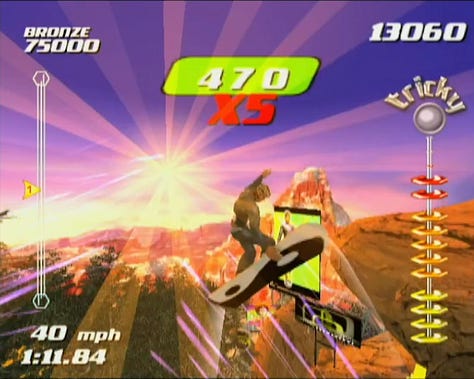
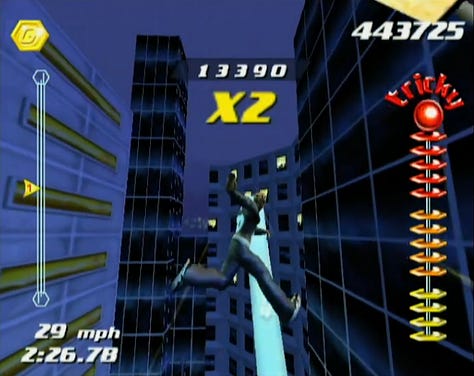
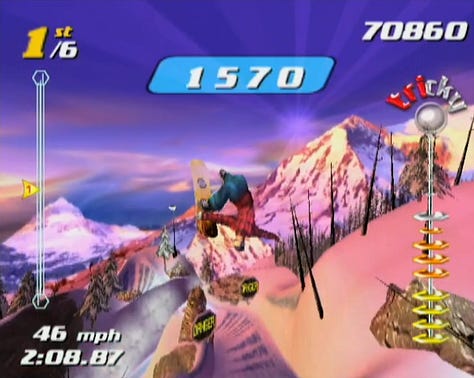
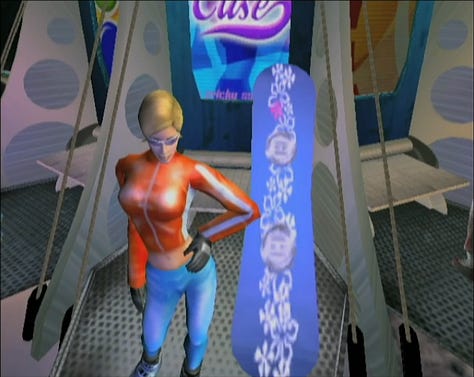
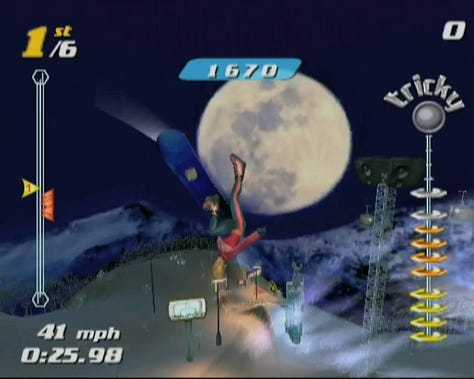
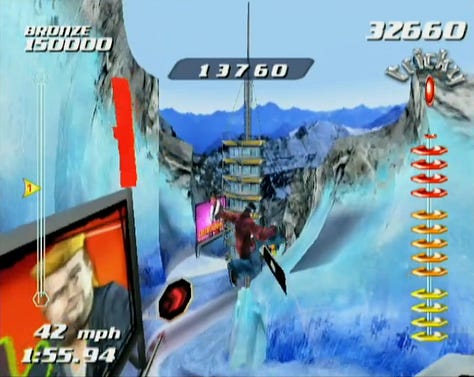
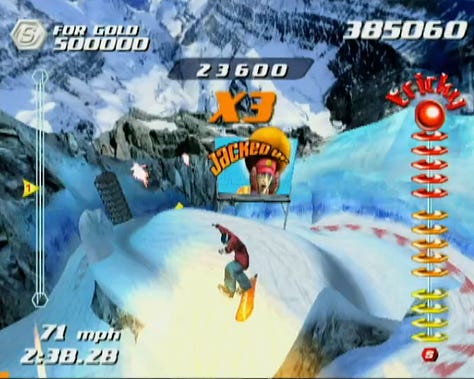
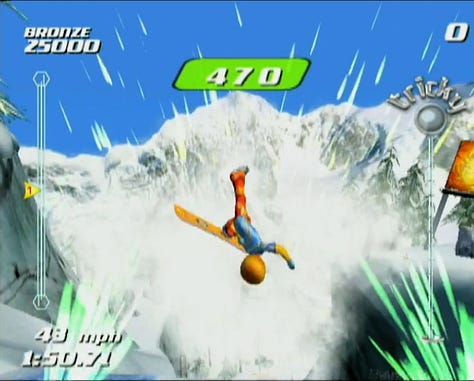
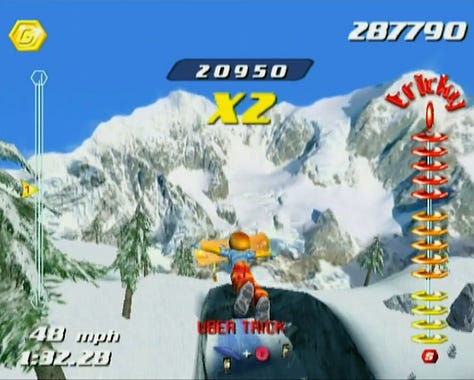
References
SSX Tricky - Making of/Behind the Scenes
Behind the Groundbreaking Sound of SSX and SSX Tricky - Jack Yarwood




But do you still have it cause now I definitely need to play again. So cool to learn the background of the game. Serious nostalgia!